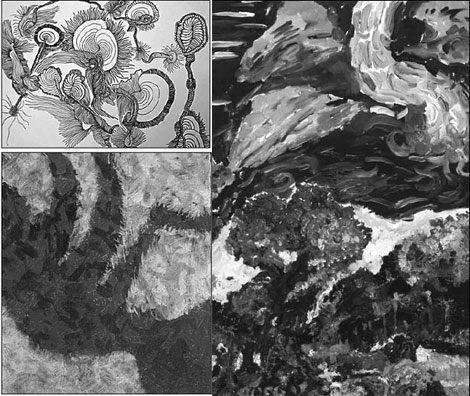Outsider art breaks down barriers
 0 Comment(s)
0 Comment(s) Print
Print E-mail China Daily, August 2, 2013
E-mail China Daily, August 2, 2013
 |
|
The ongoing exhibition Power of Natural Impulses at Beijing's Namo Space features works (clockwise from above right) by Zhang Sen, Francois Bossiere and Xie Hong. |
For years, art curator Zhang Yanbo had wanted to present a visual experience that would destroy boundaries of nationality, age, gender, religion and social rank.
The concept became clearer when Zhang chanced upon long-time friend Francois Bossiere's oil series Chromoto-pies. The French artist infused blocks of colors with a folding texture on the canvas.
In Bossiere's paintings Zhang found childlike discovery and experimentation transformed into visual delights. She had seen the same passion for creativity in paintings created by autistic children.
"They all painted from instinct, from being curious and imaginative, crossing the fences of either illness or painterly doctrines. In an unsophisticated manner, their works strike deeply on our soul," she says.
Zhang juxtaposes dozens of works of Bossiere and three teenage autistic painters at an exhibition titled Power of Natural Impulses at Beijing's Namo Space.
Zhang Sen, 15, is the oldest of the three self-taught painters. The boy from Shenzhen, Guangdong province, was diagnosed with Asperger's syndrome, an autistic spectrum disorder, at the age of 4. His works give full expression to his obsessions of the mysteries of the universe, military subjects and science fiction.
He started drawing pencil and ink sketches, and robots and machines become recurring subjects. He painted aeroboats and fierce battles between pilots and warships, drawing inspiration from fantastic scenarios in Hayao Miyazaki's animations.
"I'm a fan of Miyazaki. I've never missed any of his works," Zhang Sen says.
He likes applying thick paint all over the canvas. His bold brush strokes remind viewers of van Gogh's works. "People say I lavish too much on pigments. I just don't want to leave blank space on a canvas," he says, adding that he hopes to try his hand at sculpture.
Curator Zhang Yanbo believes autistic painters like Zhang Sen have artistic values equal to professionally trained artists. She says she doesn't exhibit their works out of charity, but because their status as "raw artists" should be acknowledged by more people.
The term, "Art Brut", translated to "raw art," in English, was coined by Frenchman Jean Dubuffet in the 1940s. It refers to art created by people outside established art circles, such as children, patients with mental illness and adults who have not studied academically.
The exhibition also displays several drawings in ink and pen by Xie Hong, 54, a retired staff member from a university library. Xie had never thought about painting until she heard of raw art from her sister, who saw such works abroad, six years ago. She began scrawling unconsciously on the paper, and has gradually formed her own style - drawing circles and curving lines.
Zhang Yanbo was introduced to Xie's works only weeks before the exhibition and invited her to join right away. "She was nearing her 50s when she finally had the gifts bestowed by heaven awakening."
Bossiere says he was excited to exhibit together with the four raw painters after he first saw their work in a digital format. He was touched by their innocence and liveliness and natural approach and how they care little about how their works will be interpreted.
Yu Shuo, Bossiere's wife and a cross-cultural anthropologist, says the exhibition by three "non-mainstream" teenagers and a retired woman is a breath of fresh air. "Art is as essential to their daily life as food. They create distinguished works in accordance with their own life pace, while together, they take on a refreshing, honest and virtuous look."






Go to Forum >>0 Comment(s)